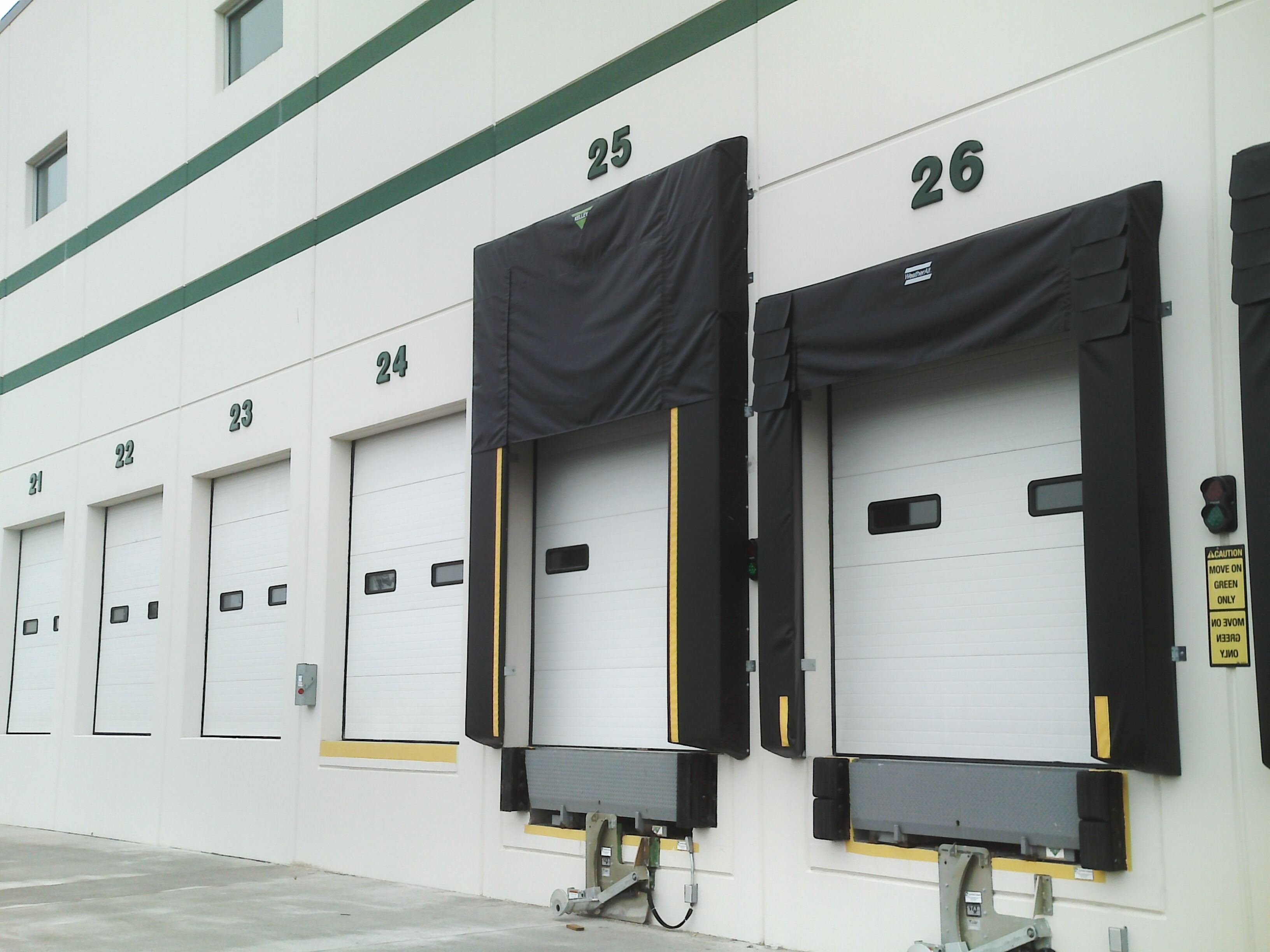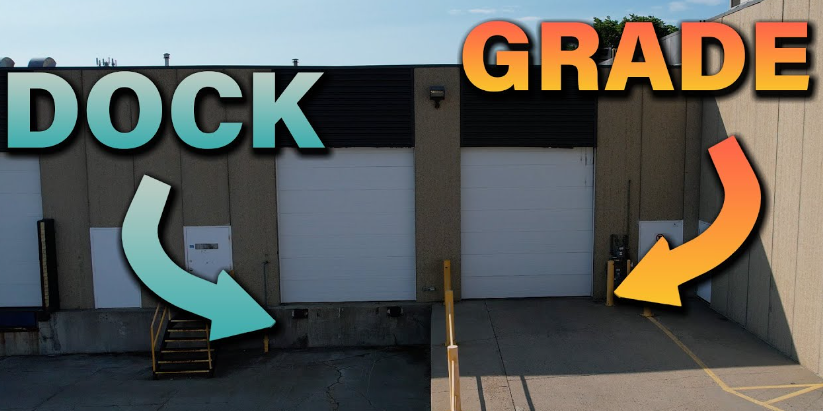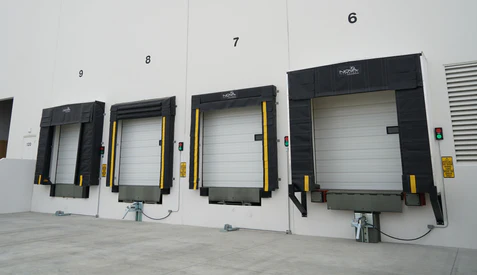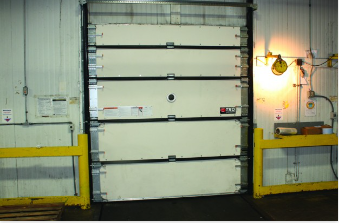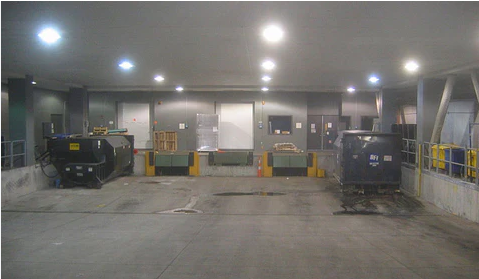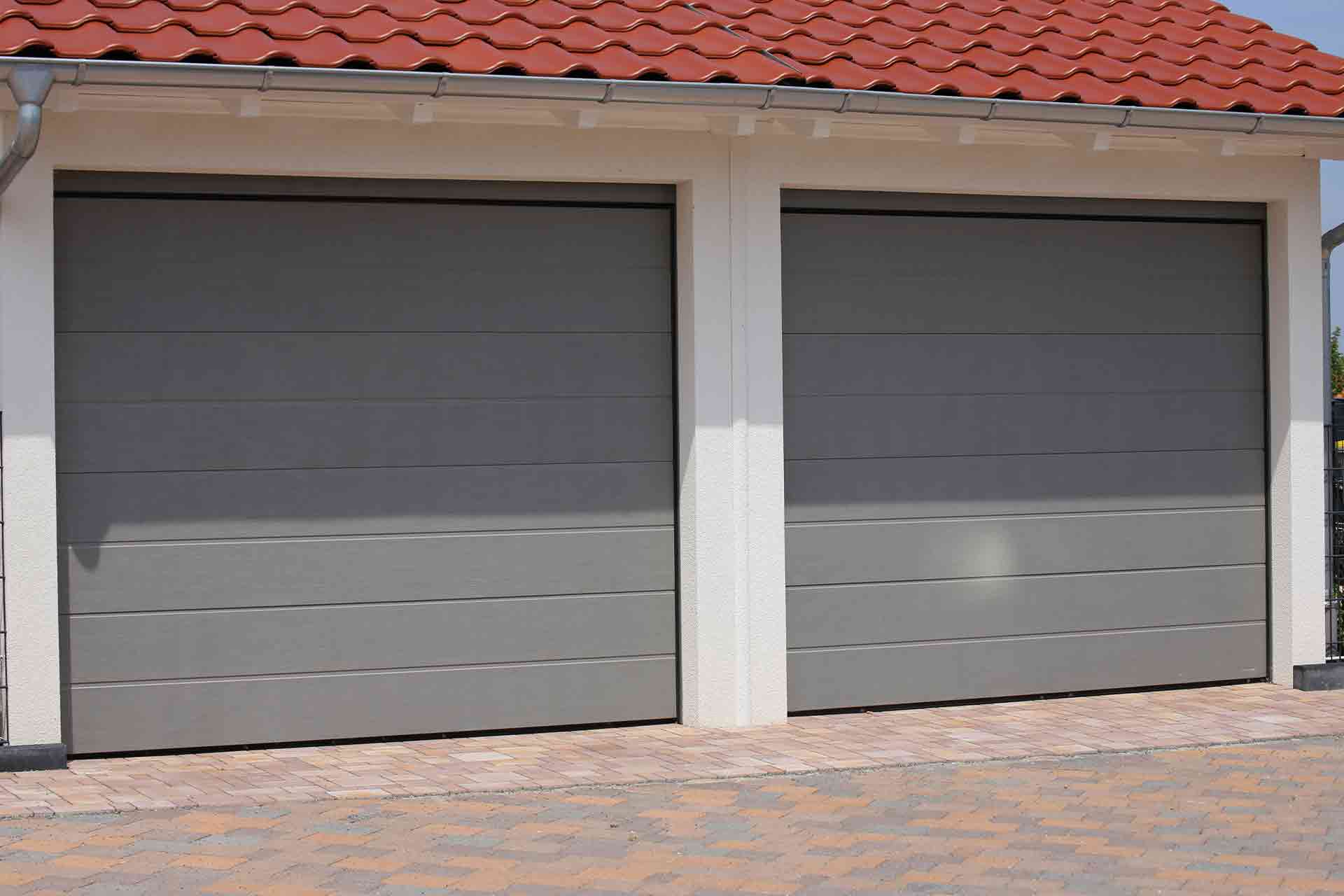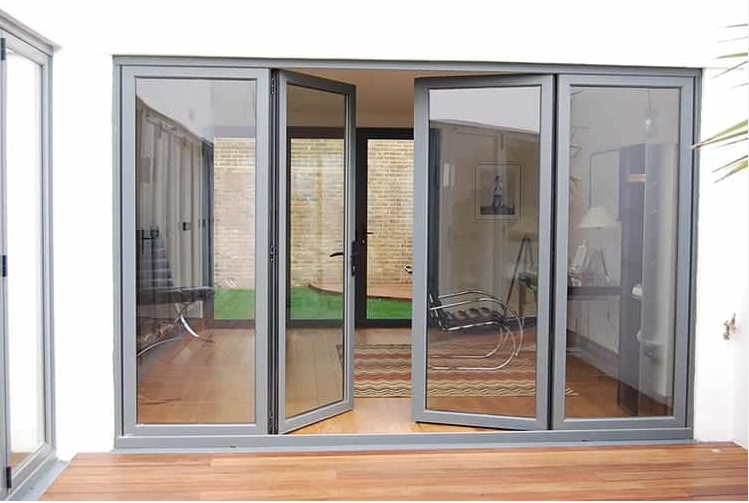Which type of door is often used as a loading dock door?
Rolling steel doors are often used as loading dock doors due to their durability and functionality. Constructed from interlocking steel slats, they can roll up into a compact coil, saving space and providing quick access. Their strength and customizable features make them suitable for various commercial and industrial applications.
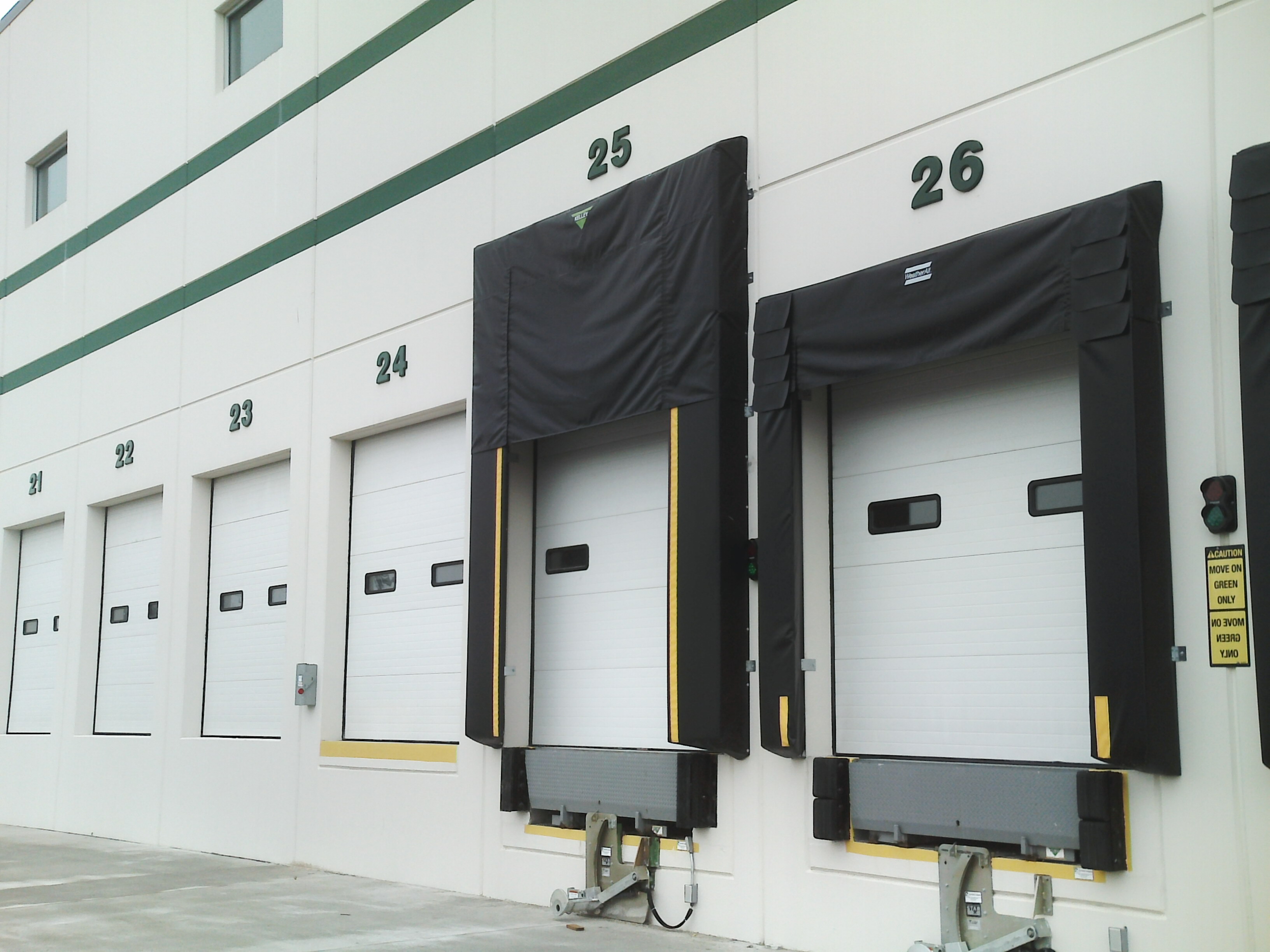
Features of Loading Dock Doors
Security and Safety Features
Locking Systems
These locking systems can have numeric keypads or biometric access controls, reducing the risk of unauthorized entry.
Safety Sensors
Safety is paramount in the loading dock environment, and modern doors are often equipped with motion and obstacle sensors. These sensors can detect any object or person in the path of the door, automatically stopping the door from closing, thus preventing accidents. They are designed to operate with a 99.7% accuracy rate.
Insulation and Energy Efficiency
Thermal Insulation
Loading dock doors are built with materials that offer high thermal insulation. This insulation could have an R-value of 16, which ensures that the temperature inside the dock remains stable, thereby reducing energy costs by up to 30% annually.
Energy Efficient Motors
The motors used to operate the doors are designed with energy efficiency in mind, often operating at 80% efficiency. This can save a significant amount on energy bills, especially in high-traffic environments.
Durability and Weather Resistance
Material and Build Quality
These coatings can protect against corrosion and provide a lifespan of up to 25 years, even in climates with extreme temperature fluctuations.
Wind Resistance
In areas prone to strong winds, loading dock doors are designed to withstand wind speeds of up to 120 mph without structural damage.
Speed and Productivity
Maintenance
With easy-to-replace parts and low maintenance requirements, the average maintenance cost of a loading dock door may be around $200 per year, adding to the overall productivity and efficiency.
Integration with Automation Systems
It allows for seamless operation with other equipment and processes, reducing loading and unloading times by 15%, on average.
Sectional Overhead Doors
Sectional overhead doors are becoming increasingly popular in various industrial and commercial applications. They consist of several panels connected by hinges, allowing the door to open vertically and slide along the ceiling.
Design and Aesthetics
Material Choices
Sectional overhead doors are often made of steel, aluminum, or even glass. These materials offer durability and an attractive appearance. Steel doors can have a thickness of 2 inches, providing a robust structure.
Customizable Appearance
Different color schemes, window inserts, and panel designs are available to match the architectural aesthetics of a building. Companies may choose a specific color that aligns with their branding.

Functionality
Space Saving
These doors open vertically, consuming minimal wall space. This design enhances the functionality of a space, particularly in smaller loading docks.
Integration with Technology
Sectional overhead doors can be integrated with modern automation systems that allow remote operation, scheduling, and monitoring through smartphones and computers.
Insulation and Energy Efficiency
Insulation Properties
These doors often come with polyurethane insulation, providing an R-value of 18. This level of insulation can help in maintaining the internal temperature and reducing energy consumption by approximately 20% annually.
Weather Sealing
Weather stripping and seals around the door prevent drafts, further improving energy efficiency and keeping the internal temperature stable.
Durability and Maintenance
Durability Standards
Constructed with corrosion-resistant materials, sectional overhead doors can last up to 30 years with proper maintenance.
Maintenance Costs
The maintenance of sectional overhead doors costs around $250 annually, including minor repairs and regular servicing.
Pricing and Economic Factors
Costing
The average cost of a standard-sized sectional overhead door falls between $1,500 and $4,000, depending on materials, customization, and features.
Impact on Property Value
By installing a high-quality sectional overhead door, property owners may increase the value of their property by 5%, as it adds to both functionality and appearance.
Sizes and Models
Available Sizes
Sectional overhead doors come in various sizes, commonly ranging from 8 feet wide to 20 feet wide and 7 feet high to 14 feet high.
Model Variations
Various models cater to different needs and budgets. The popular Model X500, for example, offers enhanced insulation and comes with a five-year warranty, priced at $3,000.
Rolling Steel Doors
Rolling steel doors are a popular choice for commercial and industrial applications due to their robust design and functionality.
Design and Materials
Structure and Materials
Constructed from interlocking steel slats, rolling steel doors offer a combination of strength and flexibility. The slats might be 22-gauge steel, and the entire structure is coated to resist rust and weather conditions.
Fire Resistance
Some models of rolling steel doors are designed with fire resistance in mind, complying with strict safety standards and able to withstand temperatures up to 1,500°F for up to 4 hours.
Functionality and Efficiency
Opening Speed
Rolling steel doors can be operated manually or electronically, with the automated versions capable of opening at a speed of 12 inches per second, facilitating quick access.
Space Utilization
With the door rolling up into a compact coil, space efficiency is optimized, particularly in tight spaces where horizontal opening doors may not be suitable.
Durability and Maintenance
Longevity and Quality
A well-maintained rolling steel door can last up to 20 years, even in demanding environments. The galvanized steel used in construction ensures quality and resistance to wear and tear.
Maintenance Needs
Regular maintenance, which might cost around $300 per year, includes lubrication, alignment checks, and occasional replacement of worn parts.
Safety Features
Wind Load Resistance
Certain models of rolling steel doors can withstand wind speeds of up to 140 mph, making them suitable for regions prone to hurricanes and strong winds.
Safety Mechanisms
Sensors and mechanical safety edges can prevent accidental closure on objects or personnel, operating with a 98% success rate.
Economic Considerations
Pricing
Prices for rolling steel doors vary based on size and features, ranging from $2,000 to $7,000 for standard commercial sizes.
Energy Efficiency
With proper insulation options, these doors can aid in maintaining internal temperatures, potentially reducing heating or cooling costs by up to 15% annually.
Sizes and Customization
Standard Sizes
The doors come in standard sizes ranging from 10 feet wide to 30 feet wide, and 8 feet high to 24 feet high.
Custom Options
Companies can customize rolling steel doors to fit specific needs, including adding windows, ventilation options, or specific coatings for added durability.
Specific Models and Features
Model R-4000
The Model R-4000 offers enhanced security features, fire resistance, and a unique aesthetic appeal, priced at $4,500 for a standard size.
High-Speed Fabric Doors
High-speed fabric doors are a modern solution for various commercial and industrial applications, designed to function quickly and efficiently.
Aesthetic Options
Different colors, transparencies, and print designs are available, allowing businesses to tailor the appearance to match branding or aesthetic preferences.
Functionality and Efficiency
Opening and Closing Speed
These doors are renowned for their speed, with some models opening at 48 inches per second. This enhances workflow efficiency by reducing waiting times at entry and exit points.
Automation and Controls
Integration with automation systems allows for remote operation and monitoring, and customizable settings for different operational scenarios.
Durability and Maintenance
Wear and Tear Resistance
Despite their lightweight construction, high-speed fabric doors resist wear and tear effectively, with an estimated lifespan of 10 to 15 years under standard usage.
Maintenance Costs
Typical annual maintenance costs range from $150 to $250, covering inspection, cleaning, and minor adjustments.
Safety Features
Collision Recovery
If accidentally struck, some high-speed fabric doors can automatically reset themselves without manual intervention, reducing downtime.

Safety Sensors
Advanced sensors can detect obstructions, halting the door’s motion to prevent accidents, with a 99% success rate in detection.
Economic Considerations
Energy Efficiency
The rapid opening and closing minimize air exchange, which can result in up to a 20% reduction in heating or cooling costs annually.
Pricing
Depending on size, materials, and additional features, the cost of high-speed fabric doors ranges from $3,000 to $12,000.
Cold Storage Solutions
For cold storage applications, special high-speed fabric doors maintain temperatures as low as -30°F, minimizing energy loss.
Sizes and Models
Available Dimensions
Sizes vary significantly, ranging from 4 feet wide to 30 feet wide, and 4 feet high to 20 feet high, accommodating various industrial needs.
Model F-200
The Model F-200 is popular in food processing environments due to its washable fabric, speed of 40 inches per second, and competitive price at $5,000 for a standard size.

